To round out my nostalgia trilogy, consider the anthology. In olden days—long before the heyday of the Furby, the Tamagotchi, and the soulful crooning of Milli Vanilli—there were many successful SF paper periodicals. Not every fan could read every periodical: distribution may have skipped some areas, readers had less spare time than they might have wanted, not to mention less money for subscriptions. Anthologies, collecting the best stories, were a fan’s shortcut to reading satisfaction.
Here are five pre-1960 anthologies that I think are worth reading. I would recommend that you buy them brand new, if that were possible, but… Still, paper books can be astonishingly durable and there are many used book purveyors (online even).
As is my custom, I will omit quality anthologies mentioned in previous essays. There’s so much good stuff out there that repetition isn’t necessary.
The usual “Wow, people sure thought differently back then” disclaimer applies. As well, the one-sided gender ratio may leave readers wondering if the population during this era was composed almost entirely of men, reproducing via spores. Or perhaps budding. No, it’s just that many editors were sexist and declined to acquire or reprint works by women, or even works that might not appeal to male readers. This was also true of stories by authors of colour. Still, even though these collections are old and reflect now excoriated (but alas, not unpopular enough) biases, there are still some dangerous visions here that are worth exploring.
The Best of Science Fiction edited by Groff Conklin (1946)
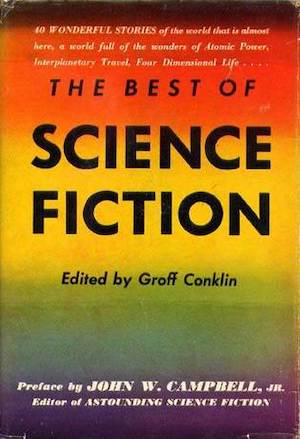
Conklin was a relentless anthologist. Selecting just one of his anthologies was difficult. I settled on The Best of Science Fiction because it’s a rarity: an SF anthology from the 1940s (when SF was generally relegated to the pulps). The Best of Science Fiction is notable also for its length: a majestic 785 pages in the original. Presumably, paper rationing was not a thing in the immediately post-war United States.
Back in 1946, there must have been a strong temptation to focus on works published in the dominant magazine of the day, Campbell’s Astounding. While Astounding is well represented in such stories as Cartmill’s “Deadline” (1944), and Heinlein’s “Blowups Happen,” Conklin draws from diverse other sources, some (like Gallun’s “Davey Jones’ Ambassador” from 1935) predating Campbell-era Astounding’s rise, and others—like Poe’s “A Tale of the Ragged Mountains” (1844) and Doyle’s “The Great Keinplatz Experiment” (1885)—predating American pulp-era SF entirely.
Imagination Unlimited edited by Everett F. Bleiler and T. E. Dikty (1952)
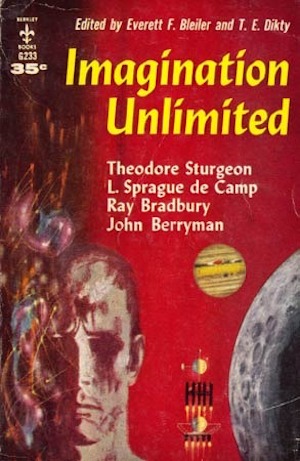
Considerably less of a chonky boi than The Best of Science Fiction, Imagination Unlimited offers thirteen stories drawn primarily but not exclusively from the pages of Astounding (whose dominance of the field was by 1953 no longer astounding but certainly not unknown). Familiar works such as Gallun’s “Old Faithful” and Neville’s “Hold Back Tomorrow” are featured, as well as works that may have slipped out of collective memory. Of historical note: “Dune Roller” is a very early Julian May piece; readers may be familiar with her much later Galactic Milieu series.
There was in those days (and may still be) a pretense that SF was in some sense a science-based genre. SF wasn’t just exciting but educational! Imagination Unlimited’s organization reflects this. The contents are sorted into four general categories:
- Mathematics and Philosophy
- Physical Sciences
- Biological Sciences
- Social Sciences
As someone who often spends as much time on structure as content, this approach delights me. That said, please don’t try to educate yourself by drawing entirely on genre sources.
Tomorrow, the Stars edited by “Robert A. Heinlein” (1952)
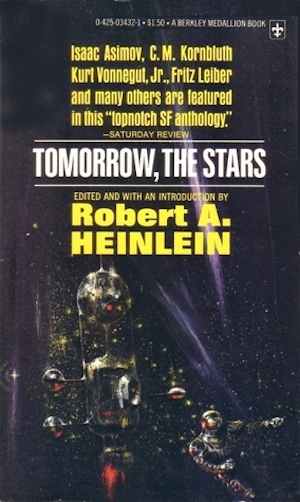
Under the “not all great anthologies are Groff Conklin anthologies” rule, I try to avoid mentioning editors or authors more than once per piece. However, the backstory for Tomorrow, the Stars is curious enough that I will waive it just this once. For marketing reasons, the anthology was credited to genre superstar Heinlein, but most of the actual editing was carried out by Frederik Pohl and Judith Merril. Consequently, there was a period in which “Robert A. Heinlein” was listed on ISFDB as one of Frederik Pohl’s pen names, which is both true and extremely misleading.
At 249 pages, Tomorrow, The Stars is thinner than the two anthologies mentioned above. However, it is a perfectly cromulent survey of predominantly but (thanks to 1941’s “Jay Score ”) not entirely post-war American SF. Fans of the period will spot familiar faces here (the authors of “Absalom,” “Betelgeuse Bridge,” and “Keyhole,” for example). Younger readers will find the anthology a solid introduction to the period.
Star Science Fiction Stories edited by Frederik Pohl (1953)
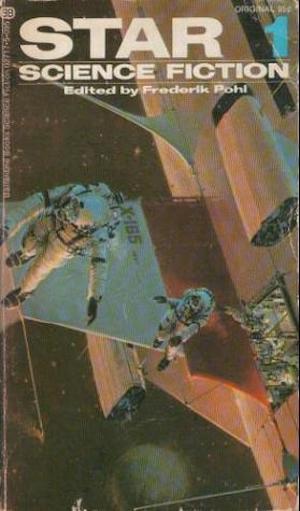
Although Frederik Pohl never explicitly states that this is an anthology of all original pieces, perusal of the ISFDB indicates that it was exactly that. As magazines declined in importance following the deliberate destruction of the American News Company, original anthologies such as Orbit rose in importance. When Pohl inaugurated his Star anthologies, magazines were thriving, but (assuming I have not been misled by databases and missing pages) elected to draw on his editorial experience by acquiring original pieces.
The series ran from 1953 to 1959. I am reviewing just the first volume here; I think the others would also repay reading (or rereading). This volume includes an impressive array of classic stories, each accompanied by a short author bio. Note to future anthologists: I am a huge fan of ancillary commentary in collections and anthologies.
Perhaps the best-known story in the collection is Arthur C. Clarke’s “The Nine Billion Names of God,” a hard SF story in which the hard science in play is applied theology.
The Star series sold well enough to warrant reprinting at least seven times (I bought the copies with John Berkey covers rather than the original Richard Powers covers). In fact, I believe that this series inspired two later anthology series: Judy-Lynn del Rey’s disco era Stellar anthologies and Patrick Nielsen Hayden’s considerably more recent Starlight series.
SF: The Year’s Greatest Science Fiction and Fantasy edited by Judith Merril (1956)
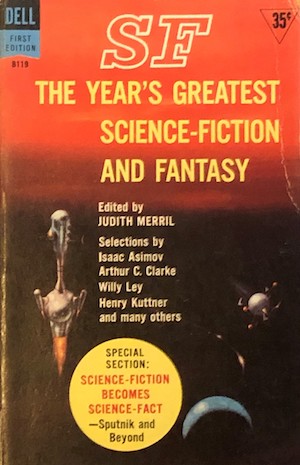
Although predated by Everett F. Bleiler and T. E. Dikty, Merril stands out as one of the pioneers of annual Best SF series. Moreover, she was for an astonishingly long time the only woman to have solo-helmed an annual Best SF. I may be overlooking someone, but I believe that Guran’s The Year’s Best Science Fiction & Fantasy Novellas: 2015 Edition might have been the first solo woman-helmed Best SF annual anthology to come out after Merril shuttered her series in the 1960s.
Merril often ranged outside conventional genre boundaries, which may explain how it is her anthology features not merely an introduction by Orson Welles, but one of that Steve Allen’s speculative fiction stories as well. Perhaps the best-known story in the set is Shirley Jackson’s “One Ordinary Day, with Peanuts,” featuring a husband and wife whose hobbies are quite different while still complementary. Other stories in the volume will reward your attention, as well.
***
No doubt those of you who are not astonished to discover that there was a world before 1960, let alone one featuring an SF industry, have your own favourites not mentioned above. Perhaps I mentioned them in prior essays. Perhaps I have never heard of them. Either way, feel free to make a case for your favourites in the comments, which are, as ever, below.
In the words of fanfiction author Musty181, four-time Hugo finalist, prolific book reviewer, and perennial Darwin Award nominee James Davis Nicoll “looks like a default mii with glasses.” His work has appeared in Interzone, Publishers Weekly and Romantic Times as well as on his own websites, James Nicoll Reviews (where he is assisted by editor Karen Lofstrom and web person Adrienne L. Travis) and the 2021 and 2022 Aurora Award finalist Young People Read Old SFF (where he is assisted by web person Adrienne L. Travis). His Patreon can be found here.










